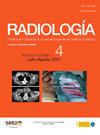肺中的神经内分泌细胞:病理光谱及其放射病理相关性
IF 1.1
Q3 RADIOLOGY, NUCLEAR MEDICINE & MEDICAL IMAGING
引用次数: 0
摘要
肺神经内分泌细胞仅占气道上皮细胞的0.4%,在缺氧检测、上皮生长和再生、肺器官发生等方面发挥着关键作用,主要通过合成和分泌胺类和多肽。肺神经内分泌细胞增生引起的病变范围从良性和惰性到恶性和高度侵袭性。最近更新的世卫组织肺神经内分泌肿瘤分类包括典型和非典型类癌以及高级别神经内分泌癌:大细胞神经内分泌癌和小细胞癌。这种分类也承认弥漫性特发性肺神经内分泌细胞增生(DIPNECH)是一种独特的疾病。放射科医生需要熟悉这些病理,因为这些症状往往缺乏特异性,因此影像学在诊断中起着至关重要的作用。了解这些病理的放射学和病理学检查之间的相关性可以增强我们对广泛的影像学表现的认识。本文章由计算机程序翻译,如有差异,请以英文原文为准。
Las células neuroendocrinas en el pulmón: Espectro de patologías y su correlación radiopatológica
Pulmonary neuroendocrine cells, which constitute a small percentage (0.4%) of airway epithelial cells, play a key role in hypoxia detection, epithelial growth and regeneration, and in lung organogenesis through the synthesis and secretion of amines and peptides. Lesions resulting from pulmonary neuroendocrine cell proliferation range from benign and indolent to malignant and highly aggressive. The recently updated WHO classification of pulmonary neuroendocrine neoplasms includes typical and atypical carcinoid tumours as well as high-grade neuroendocrine carcinomas: large cell neuroendocrine carcinomas and small cell carcinomas. This classification also recognises a condition known as diffuse idiopathic pulmonary neuroendocrine cell hyperplasia (DIPNECH) as a distinct entity. Radiologists need to become familiar with these pathologies as the symptoms often lack specificity, and thus imaging plays a crucial role in diagnosis. An understanding of the correlation between the radiological and pathological examinations of these pathologies can enhance our awareness of the wide spectrum of imaging manifestations.
求助全文
通过发布文献求助,成功后即可免费获取论文全文。
去求助
来源期刊

RADIOLOGIA
RADIOLOGY, NUCLEAR MEDICINE & MEDICAL IMAGING-
CiteScore
1.60
自引率
7.70%
发文量
105
审稿时长
52 days
期刊介绍:
La mejor revista para conocer de primera mano los originales más relevantes en la especialidad y las revisiones, casos y notas clínicas de mayor interés profesional. Además es la Publicación Oficial de la Sociedad Española de Radiología Médica.
 求助内容:
求助内容: 应助结果提醒方式:
应助结果提醒方式:


